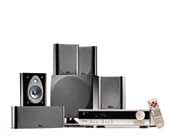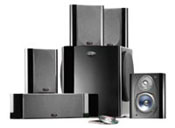Bringing Home A Real Theater Experience, A Romance In Three Parts.
Convenience or performance, which would you choose? You’re thinking about home theater. To get a real movie theater experience in your living room, a DVD player and your dinky TV speakers just aren’t gonna cut it. You need a home theater audio system. There are two ways to get a home theater audio system: “all-in-one” systems, or separate components (DVD player, multichannel receiver, etc.). Here’s a quick comparison to help you choose what’s best for you.
PART I: “ALL-IN-ONE” INTEGRATED SYSTEMS
All-in-one, single-brand systems are often called “Home-Theater-in-a-Box” systems (“HTiB” in industry slang). Like the term implies, HTiBs include most, if not all, of the audio components you’d need for home theater in one box: small speakers, a preamplifier/processor and amplification (usually in a single receiver unit) and sometimes sources such as radio, CD player and even DVD player.
HTiB Advantages
Easy to choose and buy. Just listen to the various models on display, compare features and price, and buy the one that’s best for you. Bingo bango, you got home theater.
Compatibility. There’s never a doubt whether the individual parts of the system match each other. These systems are built to work togather.
Easy to hook up. They come with all the cables you need (albeit it really cheap ones, but we’ll get to the whole “value equation” thing in a sec). Wires, connectors and jacks are usually color coded, with foolproof pre-attached connectors. Your Aunt Millie could probably hook one of these babies up.
Easy to use. You probably won’t even have to read a manual to make it work.
Compact size. HTiB systems are usually very small and come with cute little teeny-weeny speakers.
Security. They are generally offered by some of the biggest brand names in the business; Sony, Panasonic, JVC etc and so on. You know these guys.
Coolness. Some of them do look really cool.
Inexpensive. They can be stunningly cheap, as low as $199. Which leads us directly to…
HTiB Disadvantages
Limited growth potential. Most HTiBs have a limited number of inputs and other connection facilities with which to hook up additional sources. Typically, there may be only one input for an additional digital source, if that. With the rapid changes in digital and entertainment-delivery technologies these days, you may find yourself unable to connect a new entertainment source like DSS, a digital video recorder or a high-definition audio disc player. HTiB is simply not “future-ready.”
Prone to early obsolescence. Built-in sources (like a DVD player built into a receiver unit) are just not a good idea. People who purchased HTiB systems with built-in DVD players just a year or two ago have experienced the painful limitations of built-in sources when better performance progressive scan DVD players came out shortly thereafter. Combined with their limited connection facilities, these systems simply couldn’t accommodate the new improved DVD technology. And if the DVD player breaks… well, your whole system becomes just a cool-looking doorstop.
Limited upgrade path. HTiBs don’t grow with your needs. Let’s say you move into a bigger house and need a more robust subwoofer to fill the room with bass impact. Sorry. With an HTiB system, you can’t upgrade the subwoofer… or the speakers… or the DVD player… or the receiver. And those convenient wires they give you, with the unique connectors? Just wait till you try and get longer wires…
Cheap materials and poor construction. There’s a real good reason why HTiB systems are so inexpensive, folks. Pick them up. In the dictionary under “insubstantial” is a picture of your HTiB system. And that’s not just sour grapes, because it results in…
Poor sound quality. With very (VERY) few exceptions, HTiBs perform poorly. They simply don’t come even remotely close to the performance of movie theater systems or decent component systems. The few HTiB systems that do perform well cost as much as component systems. Typical HTiB shortcomings include lack of deep bass, inability to play at a lifelike volume, lack of clarity and detail. Yes, even you can hear the difference!

Weak speaker pedigree. Call us biased, but most HTiBs are made by companies that are not very good at designing loudspeakers. Walk into the sound room where the “better” audio components are displayed. See any Sony, Onkyo or Panasonic SPEAKERS there? No, and for good reason. Better speakers, ones that are capable of really thrilling, lifelike sound quality, come from companies that have dedicated their lives to building loudspeakers. Like Polk Audio. (And a few others. But I can’t seem to remember their names at the moment. Forgive me.)
Cheap speakers. Beyond their questionable parentage, the speakers included in HTiB systems are generally low quality affairs. Most of the time, you can’t even take the grille off to check the quantity and quality of the speaker parts. If you could, you would find paper cones with foam surrounds; more akin to what you’d find in cheap, cheesy computer speakers and OEM car stereos than what is typical in decent home audio speakers. Most of the time, you’d be surprised to note that there’s no tweeter at all! No wonder they sound so muffled and indistinct.
“All-in-one” HTiB systems are a good choice for:
- People with limited budgets.
- Secondary rooms and homes.
- Small rooms (under 200 sq. feet).
- Systems with small screen TVs (under 30″).
- Considerate apartment dwellers with sound-sensitive neighbors.
- People who don’t watch big explosive shoot-em-up action/adventure movies.
- People using this system only for movie and TV viewing.
- People who are uncomfortable with hooking up “high-tech” devices.
- People who have no intention of adding to, or upgrading, the system next year.
PART II: COMPONENT “SEPARATES” SYSTEMS
A home theater system made up of separately-purchased “components” would include (for instance) a multi-channel Dolby Digital receiver (or preamp/processor with separate amplifiers), a set of speakers and whatever source components you choose, such as CD player, DVD player, VCR, etc. Each component would be chosen separately, and they often originate from different manufacturers.
Component System Advantages

Flexibility. Component systems offer tremendous flexibility and choice. You can mix and match components from various manufacturers to get the best product in each category and exactly meet your unique needs for style, size, and performance.
Style choice. You can choose from a wider range of speaker types (floorstanding, bookshelf, compact, etc.), styles and colors or finish choices when you build a component system than you could with pre-packaged HTiB systems. If you were looking for a brushed aluminum receiver (looks cool!) to combine with Cherry wood finish floorstanding speakers (match your furniture), you’ll be able to get that combo with components. You’d be out of luck with HTiB.
Extreme upgradeablity. Add or upgrade one component at a time as you build toward your ultimate system goal. Use as many connectors or as much speaker wire as your little heart desires, without being stuck with a finite amount of cheap speaker wire or having to find some obscure connector type.
Greater functionality. Most component receivers have multi-room or multi-zone functions, allowing you to connect speakers in other rooms of the house. And usually, that’s just the beginning.
Lowered obsolescence. For you “commitment-phobes,” building a component home theater system means you’re not married to any one source-technology. Change sources and formats anytime as technology advances. Components mean never having to say you’re sorry.
Better materials and better build quality. Lift, touch, feel. You will notice the difference, as each manufacturer puts their all into their particular product.
High performance. This is The Big Reason to build your system using components. Systems put together with complementary component parts sound a lot better than all-in-one systems. Many sound as good as, or better than, the surround sound system in your local cinema, to say nothing of your local concert hall. Even a small component system will deliver the kind of sound that raises goose bumps on your arms; sound that gets your heart pounding and puts you on the edge of your seat. For realistic musical reproduction, and real movie theater thrills, “Once you go components you never go back.”
Component System Disadvantages
More difficult to choose. Component systems are harder to choose than integrated systems. There’s wider choice of component combinations, and it’s often difficult to know what component works best with what. (The Home Theater Handbook and the Polk System Builder can help make the choices easier.) The flip side is that it can be more fun and ultimately more satisfying to choose a system that is customized for your needs rather than settling for a cookie-cutter HTiB system.
More difficult to set up. In order to give you the ability to optimize the electronics for the speakers and to optimize the system for your room, there are set-up controls and adjustments that may be complex and confusing. Instruction manuals can be difficult to understand. Fear not, mortal! The Home Theater Handbook and Polk’s friendly Customer Service folks are here to help.
More difficult to use. You may wind up with several remote controls on your coffee table. (But “universal learning remotes” are available, and getting easier to use, to overcome this “disadvantage.”)
More expensive. There are HTiB systems that sell for well under $200. You can buy a component for that kind of money, but you can’t buy a component system for that kind of money. Cobble together a good system for $500, a really good system for $1000 and a blow-your-mind system for $2000. Does that sound like too much to spend? So tell me, how much did you spend for that big-screen or that sexy Plasma TV? Putting a $299 HTiB system on a $2000 TV is like putting a dinky 4-cylinder engine in a full size Mercedes S Class sedan. Your neighbors might be impressed but there will be no real excitement in it for you.
Component Systems are a good choice for:
- Larger rooms (over 200 sq. feet).
- Primary entertainment rooms.
- Systems with large screen TVs (30″ and over).
- People who watch a lot of action/adventure movies.
- People who enjoy making their own choices.
- People using their system for realistic music reproduction as well as movie and TV viewing.
- People who are comfortable with hooking up “high-tech” devices.
- People interested in tailoring a system for their own unique needs.
- People who are looking for truly spine-tingling, gut-rumbling, tick-off-the-neighbors performance.
PART III: DON’T TAKE OUR WORD FOR IT
I admit it; Polk Audio is not the most objective source of information on this subject. I’m trying to be objective, but you know while Polk used to make an HTiB system (the DS7200, which performed like a component system); it retailed for about $2000. The vast majority of our business comes from selling loudspeakers used in our customers’ component home theater and music systems.
So don’t take my word for any of this. The only person whose opinion counts is YOURS. Here’s how you can get more info and form your own opinion:
Listen. Listen. Listen. Go to the audio/video store. Bring with you a good-sounding CD that you know and like. Take a Dolby Digital (or DTS) 5.1-channel DVD of a movie that you know well. Don’t assume that the store will have either for you to use, they often don’t have anything to just pop into the system and try out. We’ve been shocked to observe people making audio system buying decisions by listening to the radio, a TV broadcast or not listening at all! The specs on the box tell you absolutely nothing about how a system actually sounds. Besides, we’re not gonna name names or anything, but we’ve noticed that some of the spec numbers found on HTiB system display cartons really are figments of a marketing executive’s imagination. (Want to know more? See The Truth About Power Ratings).
Find a salesperson. Don’t worry, they don’t bite. Find yourself a salesperson you get along with, and insist on getting a proper demonstration of any system you are considering. If you are not shown a component system in your price range, insist on being shown one. If there are no component systems in the store leave immediately and go to a real audio dealer. (Why are you looking for an audio system in Wal-Mart anyway?) Use the demo CD or DVD you brought with you to listen to stereo music and a 5.1 soundtrack. On the DVD, listen to both loud action scenes and quiet dialogue.
Ask your friends. You do have friends, don’t you? An even better idea (than finding that perfect salesperson) is to listen to the home theater systems that your friends are bragging about having in their living rooms. Poll your co-workers, neighbors and friends to see who has home theater audio systems. Bribe them with pizza and six-packs and get invitations to come hear their systems. You may even find that you have one friend with a component system and one friend with an all-in-one HTiB. Once you’ve heard both, odds are good you’ll understand exactly what I’ve been talking about.
Train your own ear. People often say to me, “Paul, I don’t think it matters; I don’t have a ‘trained ear’ so I just won’t be able to tell the difference anyway.” What’s a “trained ear,” I ask, one that does tricks? Listen (pun intended), you may be at a disadvantage if you have a serious hearing disorder. But if you have normal “20/20” hearing you most certainly can and most certainly will hear differences between an HTiB system and a decent component system. And it won’t be subtle.
This is what you’ll hear: With an HTiB system, the bass will be thin and lack impact; the midrange will be muddy and lack detail; the high treble will be dull and lifeless. When a rocket blasts off (see the DVD Apollo 13, chapter 12), the HTiB system just won’t rattle your bones. Dialogue, especially whispers, will often be hard to understand. The musical score will sound harsh. But most of all, HTiB systems will have a hard time playing loud enough to fill a good sized room with undistorted sound (see the DVD Air Force One, chapter 7). All of these shortcomings are avoided by the strong, detailed, utterly lifelike musical and effects reproduction of a good component home theater system.
EPILOGUE
Okay, Paul, I’m convinced.A component system will outperform an HTiB system. But what about the other issues? The choice, use and hook up issues of component systems just aren’t that big of a deal if you have some guidance. Trust us, you can do it. It ain’t rocket science.
by Paul DiComo, Polk Audio (reprinted with permission)






























